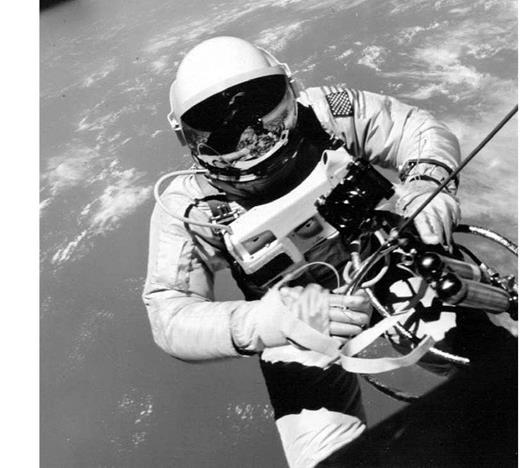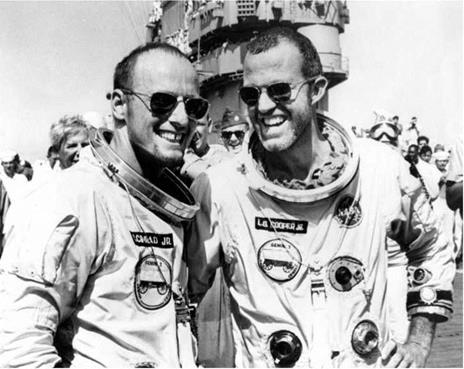GEMINI 4
|
Int. Designation |
1965-043A |
|
Launched |
3 June 1965 |
|
Launch Site |
Pad 19, Cape Kennedy, Florida |
|
Landed |
7 June 1965 |
|
Landing Site |
Atlantic Ocean |
|
Launch Vehicle |
Titan II GLV #4; spacecraft serial number 4 |
|
Duration |
4 days 1 hr 56 min 12 sec |
|
Callsign |
Gemini Four |
|
Objective |
Four-day extended-duration mission; first US EVA excursion |
Flight Crew
McDIVITT, James Alton, 35, USAF, command pilot WHITE II, Edward Higgins, 34, USAF, pilot
Flight Log
When the flight plan for Gemini 4 was initially worked out, station-keeping with the Titan second stage and spacewalking were not on the agenda. Indeed, doctors were doubtful that the mission should last four days and recommended a two-day mission. The astronauts supported an EVA, but initially this was only a stand-up EVA in the hatch. After Leonov’s exploits, they got what they wanted, but with just nine days to spare – for confirmation of the planned spacewalk was only made on 25 May 1965. Station-keeping with the second stage of the booster was the idea of Gus Grissom and Gordon Cooper, who had light-heartedly suggested such a manoeuvre during space – to-ground communications during Gemini 3.
A misbehaving gantry tower got stuck and spoiled the launch day slightly, delaying the ascent of the rookie astronauts James McDivitt and Edward White by 1 hour 16 minutes. The launch was shown live on television in Britain and the rest of Europe via the Early Bird communications satellite, at 11: 15 hrs Cape time and 10: 15 hrs Houston time, where the new Manned Space Flight Center and flight control room was situated, ready to take command of its first mission. Gemini 4 entered a 32° inclination orbit with a peak apogee of 296 km (184 miles). McDivitt’s station-keeping with the second stage of the Titan was not altogether a success, with 42 per cent of the Orbital Attitude Manoeuvring System (OAMS) propellant being consumed. The experiment was called off and the EVA delayed for an extra orbit.
On orbit No. 3, Edward White exited Gemini 4 for a 21-minute adventure that featured some of the finest space photography, courtesy of McDivitt. White’s 7.62 m (25 ft) long tether provided oxygen and he had a ventilator control module on his chest to provide nine minutes worth of emergency oxygen, if required. The excited and
|
Ed White takes a stroll during Gemini 4 |
enthusiastic White controlled his movements using an oxygen-powered hand-held manoeuvring unit, and had to be ordered back into the capsule because night was approaching. The hatch was closed 36 minutes after it had been opened, but only after some strenuous pulling by the two crewmen.
The rest of the flight, lasting a US record 62 orbits, passed quietly as the crew performed 11 scientific experiments and took a fine photo of Cape Kennedy from the cramped confines of the spacecraft. The onboard computer failed towards the end of the flight and McDivitt performed a two-phase manual re-entry, first lowering the orbit to 76 by 158 km (47 by 98 miles) before firing the retros to initiate an 8-G reentry. Splashdown at T + 4 days 1 hour 56 minutes 12 seconds was 81 km (50 miles) off target, about 625 km (388 miles) east of Cape Kennedy. The jubilant crew, having almost caught up with the Russians, were recovered by a helicopter from USS Wasp.
Milestones
16th manned space flight
8th US manned space flight
2nd Gemini manned flight
1st US and second flight with EVA operations
1st US manned launch seen live in Europe
On 29 June 1965, USAF pilot Joseph Engle, 32, flew the sixth X-15 astro-flight in the number 3 aircraft to an altitude of 85 km. Six weeks later, on 10 August 1965, he was again at the controls of X-15-3 on the seventh astro-flight, this time to 83 km.

 |
Flight Crew
COOPER, Leroy Gordon, 38, USAF, command pilot, 2nd mission Previous mission: Mercury-Atlas 9 (1963)
CONRAD, Charles “Pete” Jr., 35, USN, pilot
Flight Log
Gemini 5 was America’s bid to exceed the Soviet five-day space endurance record. Indeed, such was their determination that the first official astronauts’ flight badge featured an image of a covered wagon of the “Old West’’ whose slogan was “California or bust’’. The Gemini 5 crew emblem carried the motto “Eight Days or Bust’’. When this was proposed, the crew were told to cover the slogan, in case they should “bust’’ before the eight days were reached. Cooper’s connection with the Mercury programme was perpetuated when, after a countdown rehearsal on Pad 19, the crew had to be rescued by the “cherry picker’’ crane used at the Mercury-Redstone Pad 5, after the main gantry failed to erect itself.
The launch was delayed on 19 August by threatening storms and was recycled by 48 hours. At 09: 00hrs local time, Gemini 5 thundered into the skies right on time, entering a record US altitude of 303 km (188 miles) in its 32.6° inclination orbit. A 5m (16 ft) segment of the Titan first stage was recovered in the Atlantic, marking another US space first. The major plan for Gemini 5 was to eject a 34.4 kg (76 lb) radar evaluation pod from the rear adapter section and for the astronauts to back away 84 km (52 miles), then rendezvous with it. These plans were almost immediately thwarted when the fuel cell oxygen pressure decreased from 800 psi to 120 psi. Spacecraft power had to be conserved drastically and plans were made to bring the crew home after just three orbits.
The pressure finally dropped to 60 psi but mission planners decided to keep the crew aloft for a lazy, boring drifting flight. This seemed interminable to the crew, who in their months of training had covered almost every topic imaginable and didn’t therefore talk to each other – or the ground – much. Surprisingly, mission control
|
Conrad (left) and Cooper smile broadly upon their successful recovery after 8 days in space |
planned a five-orbit-change “phantom rendezvous” as a practice, which took them even higher to 349 km (217 miles) in the 32.6° orbit. The crew were able to perform 17 science experiments, one of which was to evaluate their ability to see things on the ground, and although they did not see a special “chessboard” target, they did see a rocket launched from Vandenberg AFB.
They also saw the wake of their prime recovery ship USS Lake Champlain on which they would later beam proudly after a flight of 7 days 22 hours 55 minutes 14 seconds, shortened by one orbit because of fears of a hurricane in the splashdown zone. Gemini 5 missed its target by 170 km (106 miles), but it did beat the Soviet endurance record. More importantly, the Americans had flown a mission lasting as long as it would take to fly to the Moon and back. The crew reportedly ripped off the patch covering their emblem slogan, having surpassed their objective.
Milestones
17th manned space flight 9th US manned space flight
3rd Gemini manned flight 1st US on-time lift-off 1st flight to be curtailed
1st manned spacecraft to be powered by fuel cells 1st flight to feature a personal crew emblem
On 28 September 1965, NASA civilian test pilot John McKay, 42, flew the X-15 number 3 aircraft on the eighth astro-flight, to 90 km. The next astro-flight occurred on 14 October 1965, when USAF pilot Joe Engle, 33, flew the X-15 number 1 aircraft on its first such flight. The programme’s ninth astro-flight attained an altitude of almost 81 km.












